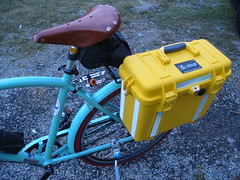
Like many bicycle commuters, I've found that many panniers designed well for touring do not work nearly as well for commuting. An extra minute or two spent securing bags before a day of riding is a minor nuisance. For a bike/transit commuter, it can mean a missed connection. A bag that's secure enough for carrying a sleeping bag on a rural road may be unsettlingly floppy when it's carrying a laptop with hundreds of hours of work stored on it.
I've tried various alternatives, including Oyster Buckets, a briefcase in a shopping-bag pannier, several different touring panniers, and the hard-sided "City Box" pannier from Bike Nashbar. But nothing was quite right. The Oyster Buckets were impact resistant but floppy and didn't fit a laptop well. The briefcase in a shopping bag pannier wasn't very secure on rough roads. Soft-sided touring panniers left paperwork rumpled. The "City Box" seemed like a reasonable solution at first, until the thin plastic cracked from fatigue after only a few months of urban commuting. (And I don't even ride any of Seattle's brick or cobblestone streets!)
Finally, I realized that I already what I wanted, it just didn't attach to my bike yet. It was time to modify one of my camera cases, a Pelican 1430. The Pelican is a top-loading waterproof case made of impact-resistant plastic. It is large enough inside, 13.5 x 11.6 x 5.75 inches, to hold my laptop padded with sorbothane, with room for slacks and a dress shirt. The case is built tough, Pelican cases are used for shipping expensive photographic equipment around the world. It's even bright yellow for visibility. (They're available in other colors, too, including black and orange, if yellow doesn't fit your style.)
All it needed was a way to hook it onto the bike.

Having browsed countless commercially-available panniers before starting this project, I knew the sort of system I was after, relatively low profile plastic mounting hooks with a simple but secure latching mechanism. No wire hooks that tend to snag, no bungee cords to flop and rattle, no straps to tighten. Checking out the available options, I selected the Klickfix-brand quick-release system used by REI on its Safari and Transfer panniers. The Klickfix system is German, and used by a number of higher-quality pannier brands. I mention REI because they stock spare parts for their equipment, so it was easy to get a pannier mounting set.
The top rail of the mounting system fit nicely below the hinge reinforcements of the case lid, requiring only a quick razor-blade shaving of two ridges. Wary of fatigue failure after my experience with the City Box pannier, I installed the mounting rails using 1.5" fender washers to spread the load over a larger area. I aligned the mounting system to preserve heel clearance when riding in bulky winter boots.
To preserve the case's water-tightness, I sealed all the fasteners will marine silicone caulking.

When I finally had the case mounted on the bike, looking at it, I decided to take advantage of the large flat surfaces of the case by adding SOLAS-grade silver reflective tape, figuring conspicuity could reduce the chance of testing the impact strength of the case. I mount the pannier on the left side of the bike, so bright reflective material at the outer edge of the box increases the visual width of my bike in dark weather -- the reflective stripe is about a foot to the left of my wheels. In my experience, this does encourage slightly wider passing clearance by motorists in dark, rainy weather.
For
organizing the interior, there are commercial padded dividers available
in various configurations, but I opted to recycle some coroplast
political signs for a lighter-weight, less-expensive divider set.
Only the laptop section needs to be padded, leaving a little
more
room in the other sections for clothing, wallet, keys, etc.
As
an added benefit, the box is more than strong enough to sit on.
That comes in handy when I'm commuting on the Sounder
commuter
train. The train often runs out of seating, but isn't really
standing-room only in the vestibule. I used to sit on the
floor,
but now I carry my own seat.
This page written by Josh Putnam. Please feel free to email questions, comments, corrections, suggestions, etc.
© Joshua Putnam